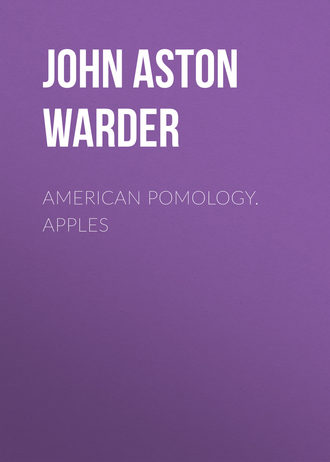 полная версия
полная версияПолная версия
American Pomology. Apples
Fruit small, regular, oblate, or globular-oblate; Surface smooth, nearly covered with very deep red, in which the stripes are almost obscured; Dots numerous, minute, white.
Basin, deep, regular, plaited or folded; Eye small, closed.
Cavity regular, acute; Stem long, red.
Core regular, closed, meeting, not clasping the eye; Seeds small, plump; Flesh white, fine-grained, crisp, tender, juicy; Flavor mild sub-acid, agreeable; Quality best; Use table; Season January.
This is different from Wilson's of Michigan, which is yellow.
Wine.—[Coxe.]HAYS' WINTER—PENNSYLVANIA RED STREAKThis handsome large apple is another index of the source of population in a western county. It is a favorite fruit with those who know it, either for market or the kitchen, for which its size and form render it peculiarly attractive.
Tree very large and handsome, spreading and very open head; leaves small, curled, and mealy, making the foliage appear rather meagre, and displaying the splendid fruit, which is evenly distributed.
Fruit large, globular-oblate, flattened or truncate, regular, occasionally unequal and lop-sided; Surface smooth, yellow, more or less covered with mixed and broken stripes of red, splashed with crimson; Dots scattered, large, gray.
Basin rather shallow, wide, abrupt; Eye small, closed, or open from breaking of the calyx.
Cavity acute, regular, brown; Stem short, thick.
Core medium, regular, closed; Seeds numerous, large, angular; Flesh yellow, firm, breaking, juicy; Flavor acid to sub-acid, rich; Quality good, for market and kitchen; Season, November and December.
Winter Queen.—[Coxe.]FALL QUEEN—KENTUCKY QUEEN—ROBERTSON'S SUPERB (of Ga.)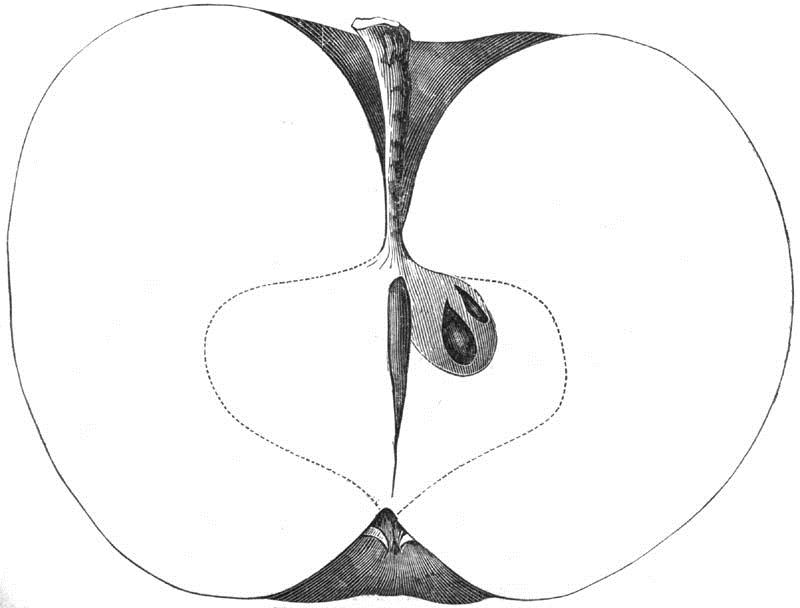
Fig. 117.—WINTER QUEEN.
This is a favorite, of southern origin, and has many synonyms. An excellent apple for drying, for family use and for market. Tree thrifty, upright, productive, early bearer; limbs long and parallel while young; shoots dark, stout; foliage large, broad, rather pale.
Fruit large, often very large, globular-oblate, somewhat conic, regular; Surface smooth, often polished, yellow, almost wholly obscured with marbled dull red, and darker stripes that are often lost in the depth of tint; Dots generally small, indented; often a slight bloom covers the fruit, but it is easily removed, when the skin appears to be polished.
Basin deep, abrupt, narrow, often wavy or even ribbed; Eye medium, closed.
Cavity deep, wide, green, wavy or regular; Stem medium.
Core regular, closed, meeting, not clasping the eye axis is sometimes very short; Seeds large, plump; Flesh greenish-white, tender, almost melting, juicy; Flavor mild sub-acid, agreeable; Quality good to very good; Use dessert, kitchen and drying; Season October to January.
YostHaving been disappointed in receiving this apple, I give Dr. W.D. Brinckle's ad interim report:
Fruit rather large, roundish-oblate, beautifully striped, and delicately mottled with crimson on yellow ground; Stem short; Cavity wide, deep; Flesh yellow, tender, juicy; Flavor pleasant; Quality very good.
CLASS I.—FLAT APPLESORDER I.—REGULARSECTION 2.—SOURSUB-SECTION 3.—RUSSETPerry Russet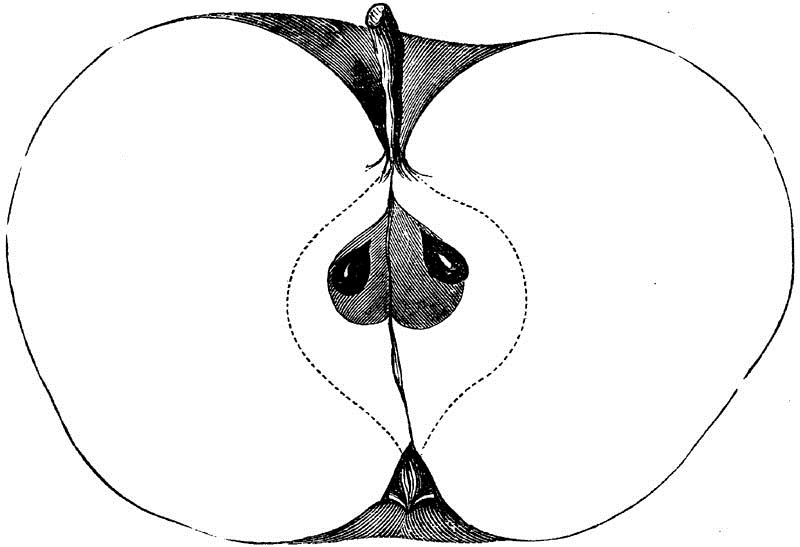
Fig. 118.—PERRY RUSSET.
This variety is grown to some extent in the North-west. The specimen from which the description is made, was exhibited by Mr. Utters, at a meeting of the North-western Fruit Growers, in 1850.
Fruit medium to large, oblate, regular; Surface smooth, yellow, covered with fine russet; Dots minute, scattered.
Basin medium, regular, wavy; Eye large, closed.
Cavity medium, regular or wavy, brown; Stem medium size and length.
Core small, closed, meeting the eye; Seeds few, plump, brown; Flesh yellow, fine grained, juicy; Flavor acid, rich; Quality almost best, for table or kitchen; Season, December and January.
Pomme Grise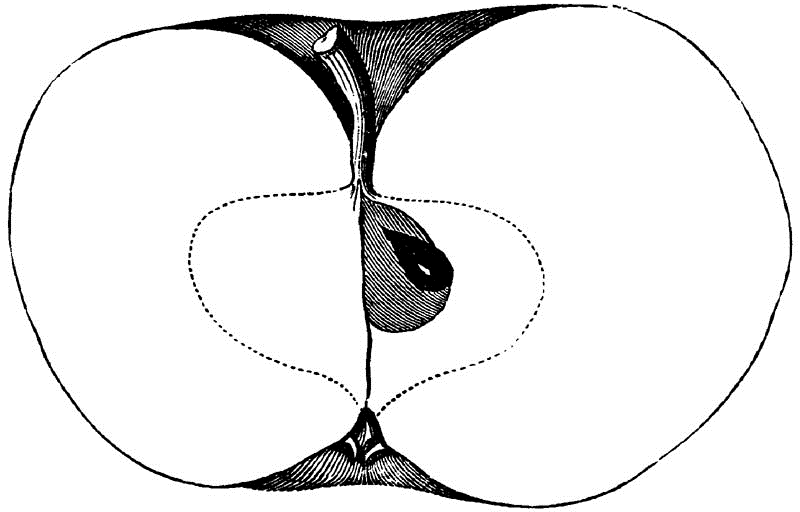
Fig. 119.—POMME GRISE.
Supposed to be of French or Canadian origin. Tree sufficiently vigorous, productive; shoots slender.
Fruit small, roundish-oblate, regular; Surface even but hardly smooth, yellow, overspread with fine russet, rarely blushed.
Basin wide, regular, sometimes abrupt; Eye very small, closed.
Cavity wide, regular; Stem short or medium.
Core full heart-shaped, regular, closed, scarcely meeting the eye; Seeds plump, angular; Flesh firm, yellow, breaking, fine grained, juicy; Flavor sub-acid, rich, aromatic, delicious; Quality best, for dessert; Season, January to March; One of the very best of the Russets.
Willis RussetThis apple was brought from Massachusetts, by my friend and neighbor B.F. Sanford, without any history of its origin. The quality of the fruit has induced me to give its description.
Fruit medium to small, roundish-oblate; Surface rough, yellow, shaded with light red, covered with russet.
Basin shallow, folded; Eye long, closed.
Cavity wide, wavy; Stem long.
Core large, wide, open, clasping; Seeds numerous, plump; Flesh yellow, breaking, fine grained, juicy; Flavor acid or sub-acid, aromatic; Quality almost first rate, for the table; Season, December and January.
CLASS I.—FLAT APPLESORDER II.—REGULAR IN FORMSECTION 1.—SWEETSUB-SECTION 1.—SELF-COLOREDAutumnal Sweet SwaarSWEET SWAAR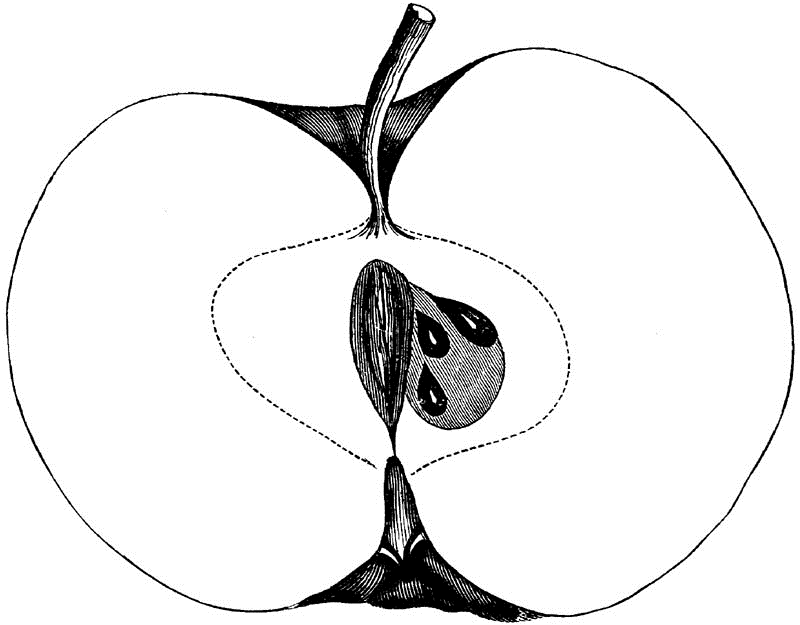
Fig. 120.—AUTUMNAL SWEET SWAAR.
The fruit is highly commended by J.J. Thomas, who thinks it "one of the finest autumnal sweet apples."
Tree vigorous, spreading, productive.
Fruit large, roundish-oblate, somewhat angular; Surface smooth, waxen yellow, sometimes blushed; Dots rare, minute.
Basin wide, shallow, plaited or folded; Eye medium, long, closed.
Cavity acute, deep, wavy, green; Stem long, inclined, yellow and red.
Core regular, globular, somewhat open, clasping; Seeds numerous, plump, pale; Flesh white, fine grained, juicy; Flavor very sweet; Quality best, for baking and market; Season, September and October.
Challenge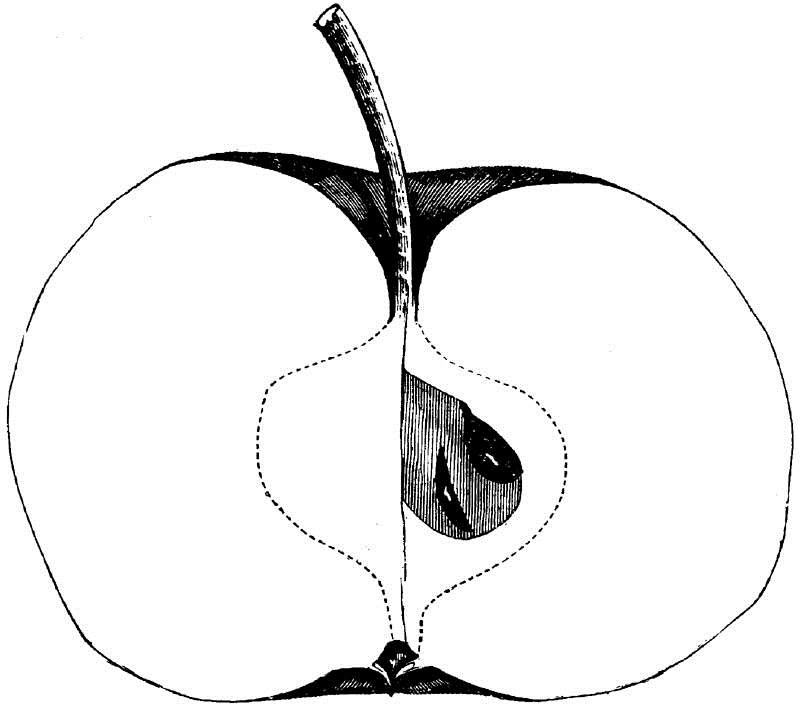
Fig. 121.—CHALLENGE.
This is another of the apples introduced by Mr. Elliott, from the orchard of D.C. Richmond, near Sandusky, O.
Tree productive, hardy.
Fruit medium, globular-oblate; Surface smooth, pale yellow; Dots black, minute, scattered, and russet spots, becoming a rich vermillion where exposed.
Basin shallow, wide, plaited; Eye small, closed.
Cavity wide, regular, brown; Stem long, slender.
Core small, oval, regular, sometimes open, not meeting the eye; Seeds large, dark; Flesh yellow, tender, fine grained, juicy; Flavor sweet; Quality almost first rate, for table; Season, October.
Delight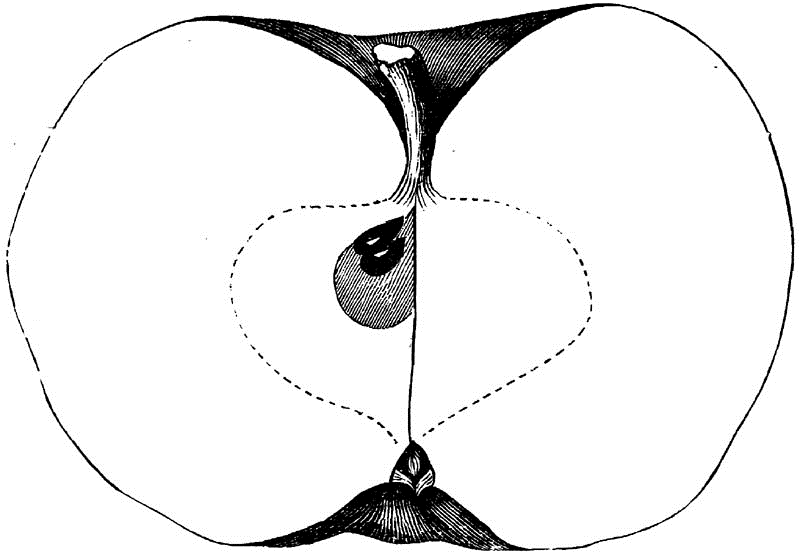
Fig. 122.—DELIGHT.
This variety is grown in the southwestern part of Ohio; origin unknown.
Fruit medium to large, round-oblate, irregular; Surface smooth, yellow, bronzed; Dots minute.
Basin narrow, folded uneven; Eye medium, closed; Segments short.
Cavity wide, regular, brown; Stem short, thick.
Core small, oval, closed, meeting the eye; Seeds numerous, plump, dark; Flesh yellow, tender, juicy; Flavor sweet; Quality pretty good; Use, market and baking; Season, January to June.
Maverack SweetOrigin South Carolina.
"Fruit large, roundish-oblate, angular; Skin yellow, mostly shaded with crimson, sprinkled with gray or greenish dots; Stalk short, inserted into a large cavity surrounded by russet; Calyx open, set in a deep, irregular basin; Flesh rich, pleasant, vinous, almost saccharine."—[Downing.]
Spice SweetingThe specimens described were from Mr. Warren, of Massachusetts. Others, found in Ohio and Illinois under this name, have a deep, abrupt basin, large or long eye, and yellow flesh; they must be different fruits.
An old variety; Tree vigorous, productive.
Fruit full medium to large, handsome, flat, irregular; Surface smooth, yellow, bronzy, crimson; Dots numerous, green.
Basin shallow, folded; Eye small, closed.
Cavity acute, wavy; Stem thick, knobby.
Core very wide, open, meeting the eye; Seeds pointed, long, dark; Flesh very white, tender, fine grained, juicy; Flavor sweet; Quality good; Use, kitchen, baking, stock; Season, September, October.
Sweet and Sour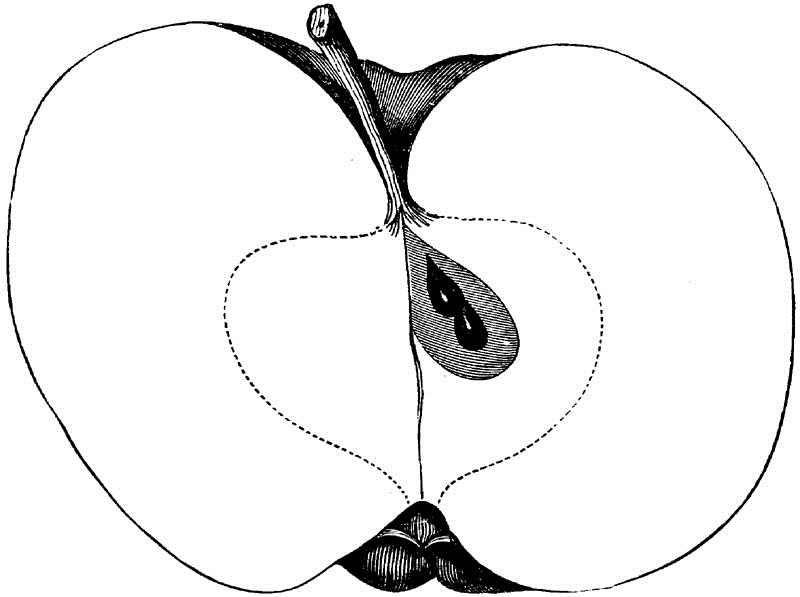
Fig. 123.—SWEET AND SOUR.
This variety is interesting as a curiosity, rather than valuable for its good qualities. It has been suggested that it might be a sport; no educated nurseryman will now believe the old story of its having been produced by the combination of the buds of two varieties, a sweet and a sour.
Fruit large, oblate, often unequal and lop-sided, ribbed, and deeply furrowed.
Surface yellow and green, the ribs being developed and ripening have flavor, but the furrows not being developed are flavorless and called sweet.
Sweet Sponge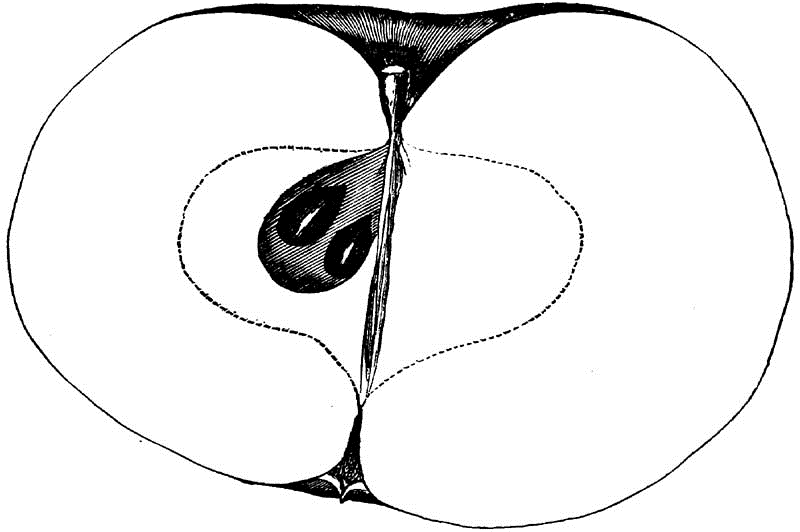
Fig. 124.—SWEET SPONGE.
From H.N. Gillett; Origin unknown.
Fruit medium, oblate, irregular; Surface smooth, yellowish white; Dots minute.
Basin none or extremely shallow, folded; Eye long, closed.
Cavity wide, irregular; Stem short, thick.
Core wide, closed, scarce meeting the eye; Seeds numerous, plump, brown; Flesh white, tender; Flavor sweet; Season, July.
CLASS I.—FLAT APPLESORDER II.—IRREGULARSECTION 1.—SWEETSUB-SECTION 2.—STRIPEDAngle SweetFruit medium, round-oblate, irregular; Surface smooth, yellow, covered with stripes and splashes of red, some darker; Dots white.
"Flesh yellow, tender, sweet, and good, fair and handsome; Season, first of September."—[Downing.
Peach Pond Sweet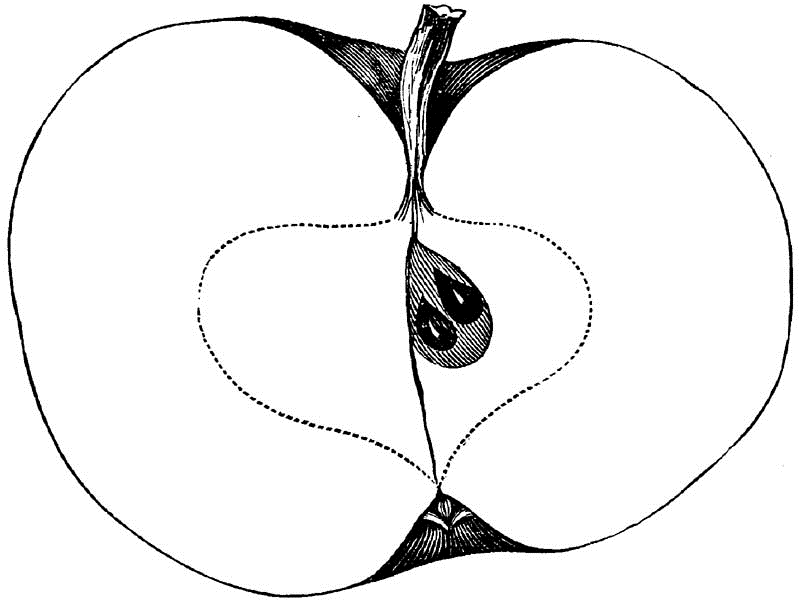
Fig. 125.—PEACH POND SWEET.
Origin Dutchess County, New York.
Fruit small to medium, round-oblate, pentangular, slightly conical; Surface smooth, pale yellow, lightly covered with mixed and striped red, and beautifully splashed crimson.
Basin narrow, regular or folded; Eye small, closed.
Cavity deep, acute, regular, brown; Stem medium to long, green, sometimes knobby.
Core regular, heart-shaped, closed, meeting the eye; Seeds small, short; Flesh yellow, tender, fine grained, juicy; Flavor very sweet; Quality almost first rate, very good; for table or baking; Season September.
Phillips' SweetOrigin believed to be Ohio; Downing says, Chotocton County, Ohio.
Tree vigorous, healthy, growth upright, very productive. Elliott thinks it may prove to be the same with Richmond.
Fruit roundish, flattened, slightly conical, obscurely angular or flattened on the sides; Surface smooth, yellow, more or less covered with red, striped crimson; Dots numerous.
Basin abrupt, regular, closed; Eye closed, segments of calyx long.
Cavity large; Stem medium length, rather slender.
Flesh yellow, tender, crisp, juicy; Flavor sweet, spicy, rich; Season, November to March.
Wing SweetTree very productive.
Fruit medium, oblate, angular; Surface very smooth, yellow, mostly covered with red, indistinctly striped darker red.
Basin wide, deep, regular or folded; Eye small, closed.
Cavity acute; Stem long.
Core small, regular, closed, scarcely touching the eye; Seeds ovate; Flesh yellow, tender, dry; Flavor sweet and rich; Quality good; baking; early winter.
CLASS I—FLAT APPLESORDER II.—IRREGULARSECTION 2.—ACIDSUB-SECTION 1.—SELF-COLOREDBlockleyBLOCKLEY PIPPIN, O. POM. SOCOriginated near Philadelphia, Pennsylvania. Tree moderately vigorous, upright, productive.
Fruit large, round-oblate, flattened at the ends, five-sided, angular; Surface smooth, greenish-yellow, blushed; Dots numerous, small, distinct, dark.
Basin wide, rather deep, wavy or folded; Eye small, closed, or partly open.
Cavity acute, narrow, uneven, brown; Stem quite short, rather thick.
Core medium, heart-shaped; Seeds numerous, angular and imperfect, dark; Flesh yellow, compact, almost melting, fine grained, juicy; Flavor rich sub-acid, sprightly; Quality almost best, for table; Season, November to January.
Bracken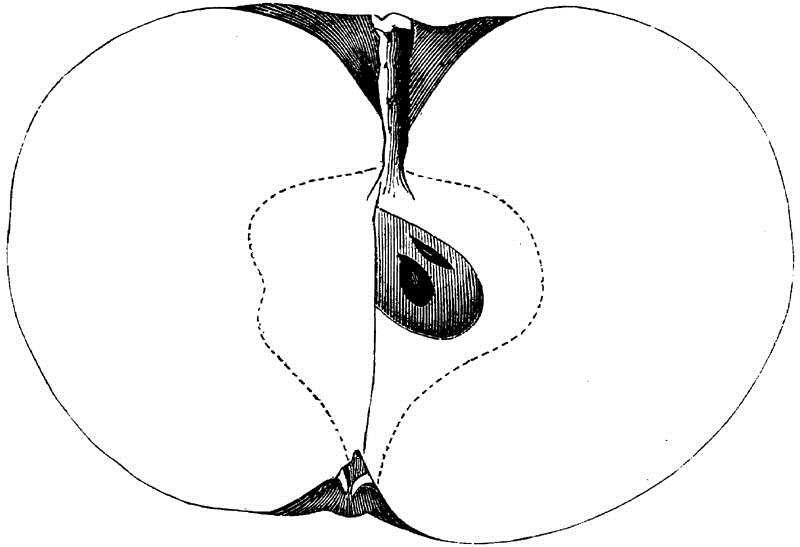
Fig. 126.—BRACKEN.
This variety has caused much discussion among the Western Pomologists, on account of its resemblance to the Early Harvest. The late Dr. Barker, one of the most intelligent fruit-growers of the country, said it was introduced as a seedling from Kentucky in 1812. Elliott does not mention it in his work, but in the discussions of the Society he is reported as having declared it the same as Early Harvest, with which it agrees in peculiar growth of twigs. H.N. Gillett, and others, familiar with the fruits of southern Ohio, consider it a distinct seedling of Kentucky. The specimen described was from that gentleman.
Fruit medium, oblate, somewhat conical, irregular and angular; Surface smooth, pale yellow; Dots scattered, dark.
Basin abrupt, medium, folded; Eye small, closed. Cavity wide, deep, irregular, brown; Stem large, knobby.
Core irregular, closed, meeting the eye; Seeds angular, imperfect; Flesh white, very tender, fine grained; Flavor mild sub-acid; Quality good; Use, table and kitchen; Season, June, July; earlier than Early Harvest.
Canada Reinette
Fig. 127.—CANADA REINETTE.
This fine fruit does not appear to be well known to our orchardists, and some of our writers have given the White Pippin among its numerous synonyms, and have suggested that they might be the same, which is not so; they are very distinct. I have omitted the synonyms, as they can be of little interest to our planters; they are not used in this country. The origin of this variety is uncertain, probably European. Downing says that Merlet, a French writer, described the fruit in the 17th century.
Tree vigorous, robust, tall spreading, productive.
The following outline and description of a specimen presented by Irvin Jessup, of Laporte, Indiana, was kindly made for me by my lamented friend, Geo. M. Beeler, a short time before his death.
Fruit large, oblate, angular; Surface not smooth, yellow, blushed and spotted red; Dots numerous, small, gray.
Basin abrupt, deep, angular; Eye small, nearly closed.
Cavity medium, acute; Stem medium, inclined.
Core wide, regular, closed, clasping; Seeds plump, angular, dark; Flesh breaking, fine grained, very juicy; Flavor acid to sub-acid, aromatic, rich; Quality very good; Use, table and cooking; Season, December to February, in northern Indiana.
Culp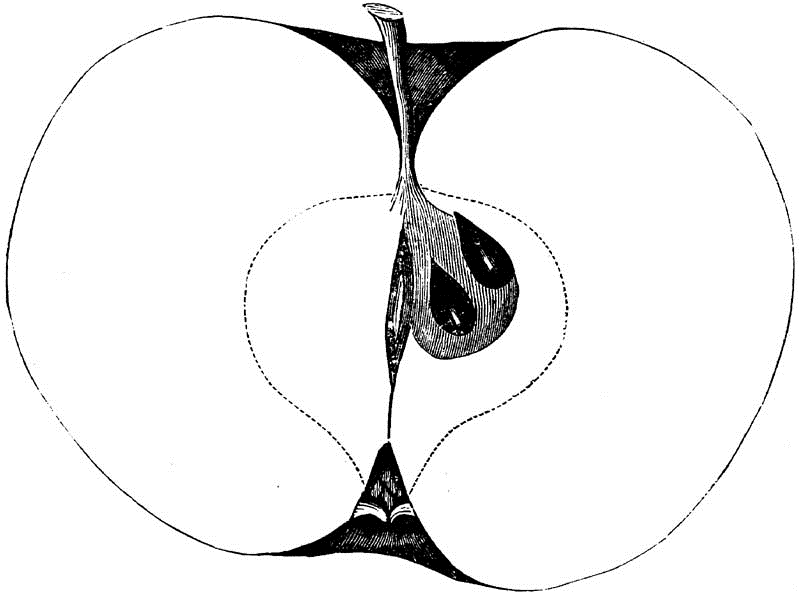
Fig. 128.—CULP.
Origin Jefferson County, Ohio; exhibited at the meetings of the Ohio Pomological Society as early as 1855, by S.B. Marshall, of Massillon, whose friend, S. Wood, had cultivated it several years; my specimens and trees are from the Massillon nursery.
Tree vigorous, thrifty, symmetrical, spreading, very productive, not an early bearer.
Fruit fair, sound, large, somewhat angular, oblate, inclined to conic, hangs well on the tree; Surface smooth, green with bronze blush; Dots minute, with green bases.
Basin narrow, rather abrupt, regular; Eye rather large, closed.
Cavity rather deep, regular, brown; Stem long or short.
Core long heart-shaped, regular, nearly closed, clasping; seeds numerous, very large, dark brown; Flesh yellowish, compact, crisp, juicy; Flavor mild sub-acid, slightly perfumed; Quality good; excellent for cooking, "compared to Rhode Island Greening;" Season, December until April.
Fall HarveyOrigin Essex County, Massachusetts. Specimen from Zanesville, Ohio.
Fruit large, oblate, irregular; Surface smooth, yellow or pale yellow; Dots minute, gray, distinct.
Basin wide, regular, leather-cracked; Eye medium, closed.
Cavity wide, wavy, green; Stem long to medium.
Core wide or globular, regular, closed, not meeting the eye; Seeds medium, pointed and defective; Flesh yellow, breaking; Flavor rich, acid; Quality only good, but valuable for the kitchen; Season, October.
Garretson's EarlyOrigin supposed to be New Jersey. Tree vigorous; an early and abundant bearer.
Fruit medium, globular-oblate, somewhat angular; Surface smooth, pale yellow; Dots whitish.
Basin small, abrupt, furrowed; Eye small, closed.
Cavity shallow; Stem short, inclined.
Flesh white, breaking, tender, juicy; Flavor pleasant sub-acid; Quality good; Use, table; Season, July and August.
Harris
Fig. 129.—HARRIS.
This variety was received from North Carolina, and fruited for the first time in the North during 1866. It was first described and figured, among other new apples, in the Horticultural Annual for 1867. In the South it is considered a summer and fall variety, being in season from August, and continuing for a long time. For specimens, I am indebted to Doctor E. Taylor, of Cleveland, Ohio.
Fruit medium to large, oblate, angular; Surface smooth, yellow, faintly blushed; Dots scattered, minute, with rosy spots.
Basin deep, abrupt, folded; Eye medium, rather open.
Cavity deep, wavy, clear yellow; Stem medium to long.
Core small, open, meeting the eye; Axis very short; Seeds numerous, angular; Flesh light yellow, breaking, fine-grained, juicy; Flavor acid to sub-acid, spicy, agreeable; Use table and kitchen; Season October; Quality good to very good.
Loudon PippinLADY WASHINGTON?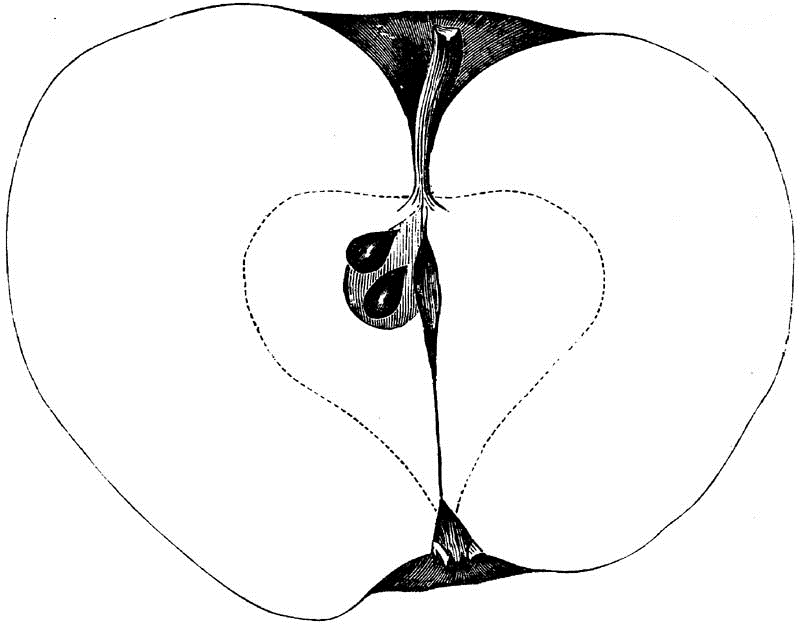
Fig. 130.—LOUDON PIPPIN.
Origin Loudon County, Virginia. Exhibited before the Ohio Pomological Society, by Joseph Sigler, of McConnellsville, Ohio.
Fruit large, oblate, conic, angular; Surface beautiful, very smooth, waxy yellow, handsomely blushed, and bright red spots; Dots scattering, gray.
Basin wide, regular or folded; Eye large, closed.
Cavity wide, not deep, regular, brown; Stem medium, red.
Core heart-shaped, regular, closed, clasping the eye; Seeds numerous, medium; Flesh yellowish, compact, tender, breaking; Flavor rich sub-acid, aromatic; Quality very good; Dessert; Season, December to February. A fine fruit from Washington County, shown at the same time as the Lady Washington; was thought to be the same.
Ohio PippinERNST'S APPLE.—BUCHANAN, ETC.—SHANNON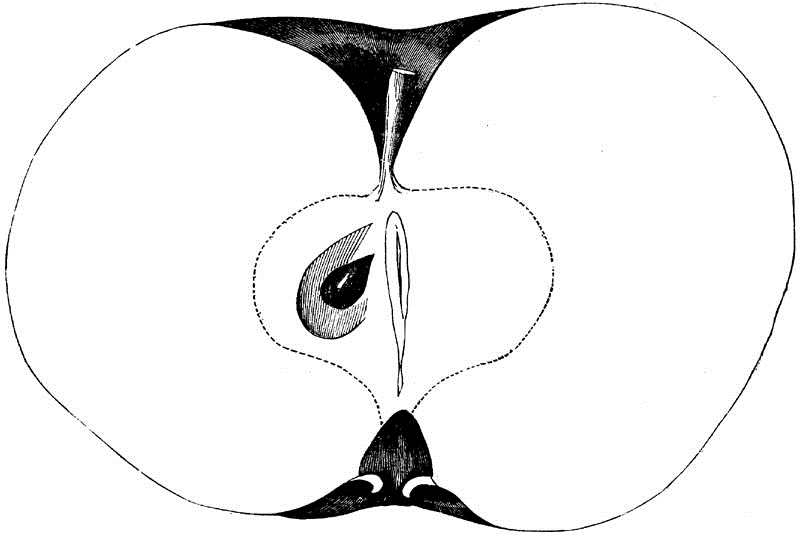
Fig. 131.—OHIO PIPPIN.
We owe our acquaintance with this fine large fruit to the late Mr. A.H. Ernst, long President of the Ohio Pomological Society, who furnished trees to Mr. Robert Buchanan, an enthusiastic Pomologist of Cincinnati. Both these gentlemen were too modest to permit their names to be attached to a fruit which they did not originate, but which they have aided to distribute. Another focus of distribution was the orchard and nursery of R.W. Todd, at Madison, Indiana, and the fruit has been received under the name of Shannon, from Doctor J.A. Dibrell, of Van Buren, Arkansas. Origin Dayton, Ohio, from whence it was procured personally by Mr. Todd, many years ago, and the grafts set by him are the oldest trees known.
Tree healthy, vigorous, large, spreading; Shoots stout, dark; Leaves large.
Fruit large, often very large, oblate, somewhat conic, irregular; Surface smooth, greenish-yellow, sometimes blushed faintly near the base; Dots small gray.
Basin wide, deep, folded; Eye large or very large, open; Segments short.
Cavity wide, wavy or regular, brown; Stem short, stout.
Core medium to large, regular, closed, meeting the eye; Seeds numerous, medium, plump, sometimes imperfect; Flesh yellowish, breaking, tender, juicy; Flavor acid to sub-acid; Quality good; Market and kitchen, too large for dessert; Season, December, January.
Western SpyOrigin Jefferson County, Ohio. Tree healthy but medium growth, very productive; exhibited by Joel Wood.
Fruit large, roundish-oblate, uneven; Surface smooth, yellow, blushed; Dots numerous, minute, with white bases.
Basin abrupt, uneven; Eye large, closed.
Cavity medium, wavy; Stem short.
Core wide, closed, not meeting the eye; Seeds numerous, large, plump; Flesh yellow, breaking; Flavor acid; quality pretty good; Use, kitchen, table; Season, December, January.
CLASS I.—FLAT APPLESORDER II.—IRREGULARSECTION 2.—ACIDSUB-SECTION 2.—STRIPEDBerryNot having enjoyed an opportunity of examining this fruit, I quote from my friend Chas. Downing.
"Origin Virginia or North Carolina. Tree vigorous, upright, very productive, and a valuable market fruit.
"Fruit rather above medium, obliquely depressed; Skin striped and splashed with red, on greenish-yellow ground, with large dots, having a dark center; Stem short, in a generally broad, deep cavity; Calyx open; Basin shallow, and uneven; Flesh rather coarse, juicy, with a pleasant sub-acid flavor; November to March."
BuffFor description of this fruit I take Downing's quotation from White's Gardener:
"Origin uncertain; Tree vigorous, erect; Fruit very large, irregular, roundish flattened and slightly irregular; Skin thick, yellow, striped, and shaded with red, very dark next the sun, marked with a few greenish russet spots; Stem three-fourths of an inch long, in a medium cavity; Calyx in a large, irregular basin; Flesh white, and when fully ripened, tender and excellent, sometimes indifferent; November to March."
DanaFrom Gabriel Sleath, near Cincinnati, Ohio. The origin of this pleasant dessert apple is not known. Tree large, productive.
Fruit small, flat, somewhat angular; Surface smooth, rich yellow partially covered mixed red, distinctly striped carmine; Dots pale fawn or yellow; heavy white bloom.
Basin shallow, leather-cracked; Eye small, long, closed.
Cavity medium, regular; Stem quite long, slender.
Core wide, regular, open, clasping; Seeds numerous, short, plump, brown; Flesh yellow, very fine grained, very juicy; Flavor sub-acid, sprightly, agreeable; Quality good to very good; Use, dessert; Season, August.
Gravenstein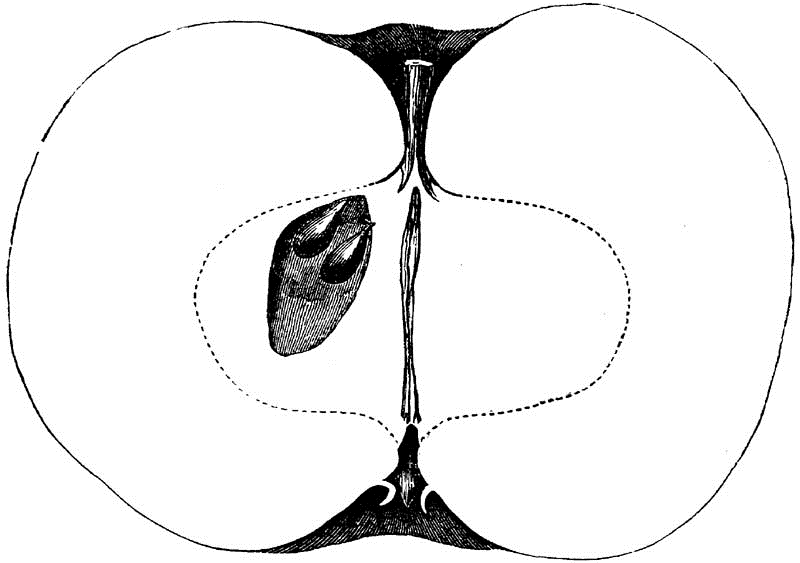
Fig. 132.—GRAVENSTEIN.
This fine European apple is said to have originated at Gravenstein, Holstein. It has long been in this country, where it succeeds very well.
Tree vigorous, spreading, productive; Shoots vigorous; Leaves long, rolled, showing the white underside.
Fruit large, globular-oblate, angular; Surface smooth, yellow, partially covered with mixed and splashed scarlet; Dots rare.
Basin medium, regular; Eye small, closed.
Cavity deep, regular; Stem short.
Core regular, globular, or pointed toward the eye, closed, clasping; Seeds small, pointed; Flesh yellow, fine grained, breaking, juicy; Flavor sub-acid, aromatic; Quality best; table and kitchen; Season, August, September.
KeiserOrigin Jefferson County, Ohio; not widely distributed. Tree thrifty, upright. The following description was made from fruit obtained of my friend T.S. Humrickhouse, of Coshocton.
Fruit full medium to large, oblate, uneven; Surface smooth, greenish-yellow, mixed and striped red; Dots scattered, minute.
Basin wide, deep, folded; Eye small, closed.
Cavity acute, deep; Stem quite short.
Core very small, regular, closed, clasping; Seeds numerous, short, plump; Flesh yellow, tender, fine grained, juicy; Quality good to best; for table and kitchen; Season, December to January.



